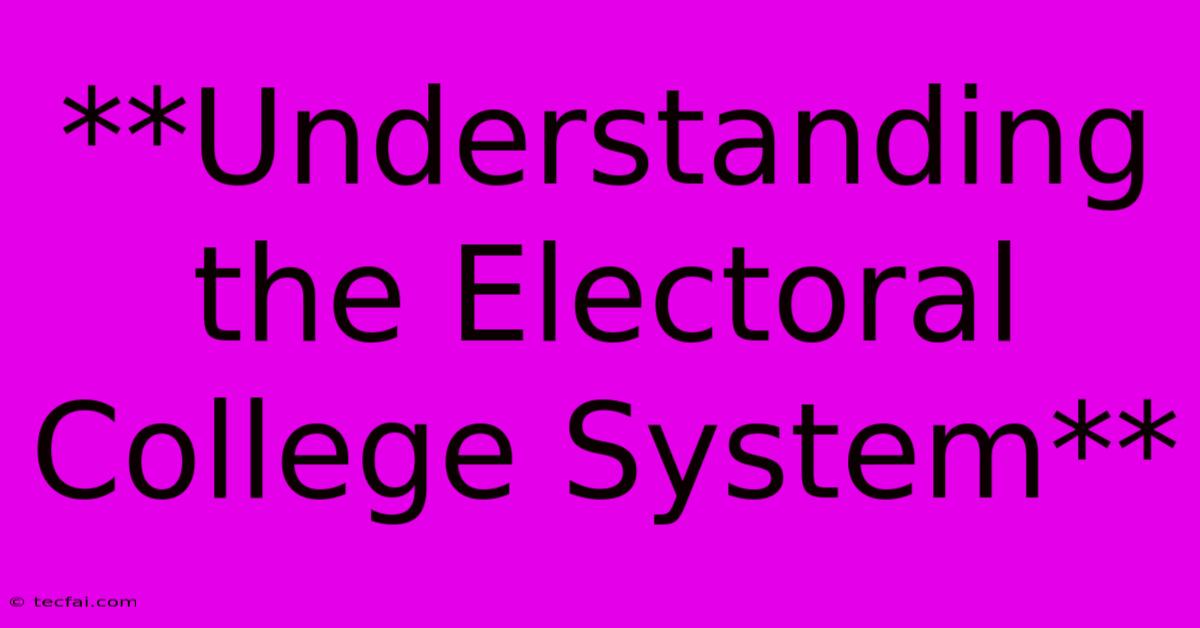**Understanding The Electoral College System**

Discover more detailed and exciting information on our website. Click the link below to start your adventure: Visit Best Website tecfai.com. Don't miss out!
Table of Contents
Understanding the Electoral College System: How the US President is Elected
The United States Presidential election is a complex process, and a key part of that process is the Electoral College. While most people are familiar with the concept of voting for a candidate, many don't fully grasp how the Electoral College system works and its potential implications. This article aims to demystify this system, providing a clear and comprehensive understanding of its mechanics and historical context.
What is the Electoral College?
The Electoral College is a body of electors established by the U.S. Constitution, constituted every four years for the sole purpose of electing the President and Vice President of the United States. Each state is allocated a number of electors based on its total number of members in Congress (House of Representatives and Senate).
Key Points to Remember:
- Each state's number of electors is determined by the total number of its U.S. Senators (always 2) plus its number of Representatives in the House. This number can change every ten years based on the results of the national census.
- The District of Columbia has three electors, as if it were a state, which is granted under the 23rd Amendment to the Constitution.
- The total number of electors is 538. This is derived from the 100 senators, 435 representatives, and 3 electors for the District of Columbia.
How Does the Electoral College Work?
The Electoral College system operates on a "winner-take-all" principle in most states. This means that the candidate who receives the most votes in a state typically receives all of that state's electoral votes, regardless of the margin of victory.
Here's a breakdown of the process:
- Popular Vote: Citizens cast their votes for President and Vice President during the general election in November.
- State-Level Tally: The results of the popular vote are tallied within each state.
- Electoral Vote Allocation: The candidate who wins the popular vote in a state generally wins all of that state's electoral votes (with some exceptions, such as Maine and Nebraska, which use a proportional system).
- Electoral College Vote: Each state's electors then formally cast their votes for President and Vice President based on the outcome of the popular vote in their state.
- Electoral College Tally: The candidate who receives a majority of the electoral votes (at least 270 out of 538) becomes President of the United States.
Why Does the Electoral College Exist?
The Electoral College was established by the Founding Fathers in 1787 as a compromise between those who wanted the President to be elected directly by the people and those who favored a system where states played a more prominent role in the selection process.
Key Reasons:
- Fear of Majority Tyranny: The Founding Fathers were wary of the possibility of a single state or region dominating national politics through direct popular vote.
- Importance of States: The Electoral College system ensured that states with smaller populations would still have a voice in the presidential election.
- Promoting Compromise and Unity: The need for a majority of electoral votes encourages candidates to campaign in a broader range of states, promoting national unity and compromise.
Criticisms of the Electoral College
While the Electoral College system has remained in place for centuries, it has faced numerous criticisms over the years.
Key Criticisms:
- Disproportionate Representation: The Electoral College system can lead to situations where a candidate wins the presidency despite losing the popular vote, as seen in several elections, including 2000 and 2016. This can create a sense of inequity among voters.
- Voter Disenfranchisement: In states where one candidate consistently wins by a significant margin, voters may feel that their votes are not relevant, as the outcome is already predetermined.
- Focus on Swing States: Candidates often concentrate their campaign efforts on a small number of "swing states" where the outcome is uncertain, potentially neglecting voters in other states.
- Potential for Electoral College Chaos: The winner-take-all system can lead to scenarios where a candidate wins the presidency with a narrow margin of electoral votes, despite a significant lead in the popular vote.
Conclusion
The Electoral College system remains a complex and controversial aspect of the U.S. political landscape. While it was created with the intention of ensuring a balanced representation of states and promoting national unity, its critics argue that it undermines the principle of "one person, one vote" and can lead to outcomes that are not reflective of the will of the people. As the debate over the Electoral College continues, it's essential to understand its workings and consider its potential implications on the future of presidential elections in the United States.

Thank you for visiting our website wich cover about **Understanding The Electoral College System** . We hope the information provided has been useful to you. Feel free to contact us if you have any questions or need further assistance. See you next time and dont miss to bookmark.
Featured Posts
-
Garth Brooks The Anthology Part Iv Release Confirmed
Nov 05, 2024
-
Us Election 2024 When Will We Know
Nov 05, 2024
-
Barcelona Flooded Again Rescuers Search
Nov 05, 2024
-
Sir Chris Hoys Early Cancer Symptom
Nov 05, 2024
-
Barcelona Faces Extreme Danger Rain Warning
Nov 05, 2024
